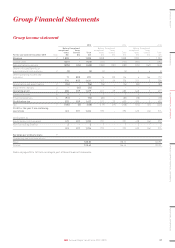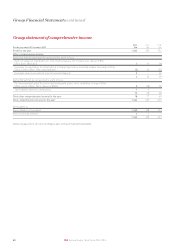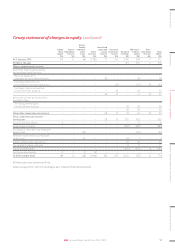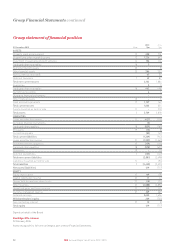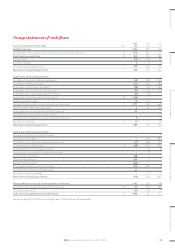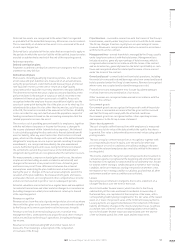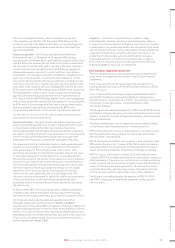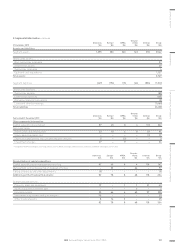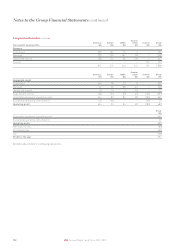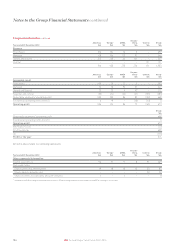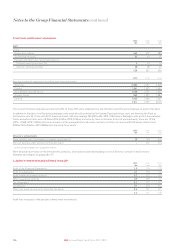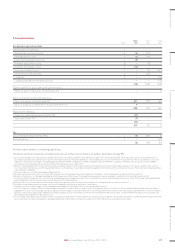Holiday Inn 2015 Annual Report Download - page 99
Download and view the complete annual report
Please find page 99 of the 2015 Holiday Inn annual report below. You can navigate through the pages in the report by either clicking on the pages listed below, or by using the keyword search tool below to find specific information within the annual report.
Deferred tax assets are recognised to the extent that it is regarded
as probable that the deductible temporary differences can be realised.
The recoverability of all deferred tax assets is re-assessed at the end
of each reporting period.
Deferred tax is calculated at the tax rates that are expected to apply in
the periods in which the asset or liability will be settled, based on rates
enacted or substantively enacted at the end of the reporting period.
Retirement benefits
Defined contribution plans
Payments to defined contribution schemes are charged to the income
statement as they fall due.
Defined benefit plans
Plan assets, including qualifying insurance policies, are measured
at fair value and plan liabilities are measured on an actuarial basis,
using the projected unit credit method and discounting at an interest
rate equivalent to the current rate of return on a high-quality
corporate bond of equivalent currency and term to the plan liabilities.
The difference between the value of plan assets and liabilities at the
period-end date is the amount of surplus or deficit recorded in the
statement of financial position as an asset or liability. An asset is
recognised when the employer has an unconditional right to use the
surplus at some point during the life of the plan or on its wind-up. If a
refund would be subject to a tax other than income tax, as is the case
in the UK, the asset is recorded at the amount net of the tax. A liability
is also recorded for any such tax that would be payable in respect of
funding commitments based on the accounting assumption that the
related payments increase the asset.
The service cost of providing pension benefits to employees, together
with the net interest expense or income for the year, is charged to
the income statement within ‘administrative expenses’. Net interest
is calculated by applying the discount rate to the net defined benefit
asset or liability, after any asset restriction. Past service costs and
gains, which are the change in the present value of the defined benefit
obligation for employee service in prior periods resulting from plan
amendments, are recognised immediately the plan amendment
occurs. Settlement gains and losses, being the difference between
the settlement cost and the present value of the defined benefit
obligations being settled, are recognised when the settlement occurs.
Re-measurements comprise actuarial gains and losses, the return
on plan assets (excluding amounts included in net interest) and
changes in the amount of any asset restrictions. Actuarial gains
and losses may result from: differences between the actuarial
assumptions underlying the plan liabilities and actual experience
during the year or changes in the actuarial assumptions used in the
valuation of the plan liabilities. Re-measurement gains and losses,
and taxation thereon, are recognised in other comprehensive income
and are not reclassified to profit or loss in subsequent periods.
Actuarial valuations are carried out on a regular basis and are updated
for material transactions and other material changes in circumstances
(including changes in market prices and interest rates) up to the end
of the reporting period.
Revenue recognition
Revenue arises from the sale of goods and provision of services where
these activities give rise to economic benefits received and receivable
by the Group on its own account and result in increases in equity.
Revenue is derived from the following sources: franchise fees;
management fees; owned and leased properties and other revenues
which are ancillary to the Group’s operations, including technology
fee income.
Revenue is recorded (excluding VAT and similar taxes) net of
discounts. The following is a description of the composition
of revenues of the Group:
Franchise fees – received in connection with the licence of the Group’s
brand names, usually under long-term contracts with the hotel owner.
The Group charges franchise royalty fees as a percentage of rooms
revenue. Revenue is recognised when the fee is earned in accordance
with the terms of the contract.
Management fees – earned from hotels managed by the Group, usually
under long-term contracts with the hotel owner. Management fees
include a base fee, generally a percentage of hotel revenue, which is
recognised when earned in accordance with the terms of the contract
and an incentive fee, generally based on the hotel’s profitability or cash
flows and recognised when the related performance criteria are met
under the terms of the contract.
Owned and leased – primarily derived from hotel operations, including
the rental of rooms and food and beverage sales from owned and leased
hotels operated under the Group’s brand names. Revenue is recognised
when rooms are occupied and food and beverages are sold.
Franchise fees and management fees include liquidated damages
received from the early termination of contracts.
Other revenues are recognised when earned in accordance with the
terms of the contract.
Government grants
Government grants are recognised in the period to which they relate
when there is reasonable assurance that the grant will be received
and that the Group will comply with the attached conditions.
Government grants are recognised within ‘other operating income
and expenses’ in the Group income statement.
Share-based payments
The cost of equity-settled transactions with employees is measured
by reference to fair value at the date at which the right to the shares
is granted. Fair value is determined by an external valuer using option
pricing models.
The cost of equity-settled transactions is recognised, together with
a corresponding increase in equity, over the period in which any
performance or service conditions are fulfilled, ending on the date
on which the relevant employees become fully entitled to the award
(vesting date).
The income statement charge for a period represents the movement in
cumulative expense recognised at the beginning and end of that period.
No expense is recognised for awards that do not ultimately vest, except
for awards where vesting is conditional upon a market or non-vesting
condition, which are treated as vesting irrespective of whether or not
the market or non-vesting condition is satisfied, provided that all other
performance and/or service conditions are satisfied.
Leases
Operating lease rentals are charged to the income statement on a
straight-line basis over the term of the lease.
Assets held under finance leases, which transfer to the Group
substantially all the risks and benefits incidental to ownership of
the leased item, are capitalised at the inception of the lease, with a
corresponding liability being recognised for the fair value of the leased
asset or, if lower, the present value of the minimum lease payments.
Lease payments are apportioned between the reduction of the lease
liability and finance charges in the income statement so as to achieve
a constant rate of interest on the remaining balance of the liability.
Assets held under finance leases are depreciated over the shorter
of the estimated useful life of the asset and the lease term.
97
IHG Annual Report and Form 20-F 2015
STRATEGIC REPORT GOVERNANCE GROUP FINANCIAL STATEMENTS ADDITIONAL INFORMATIONPARENT COMPANY FINANCIAL STATEMENTS


